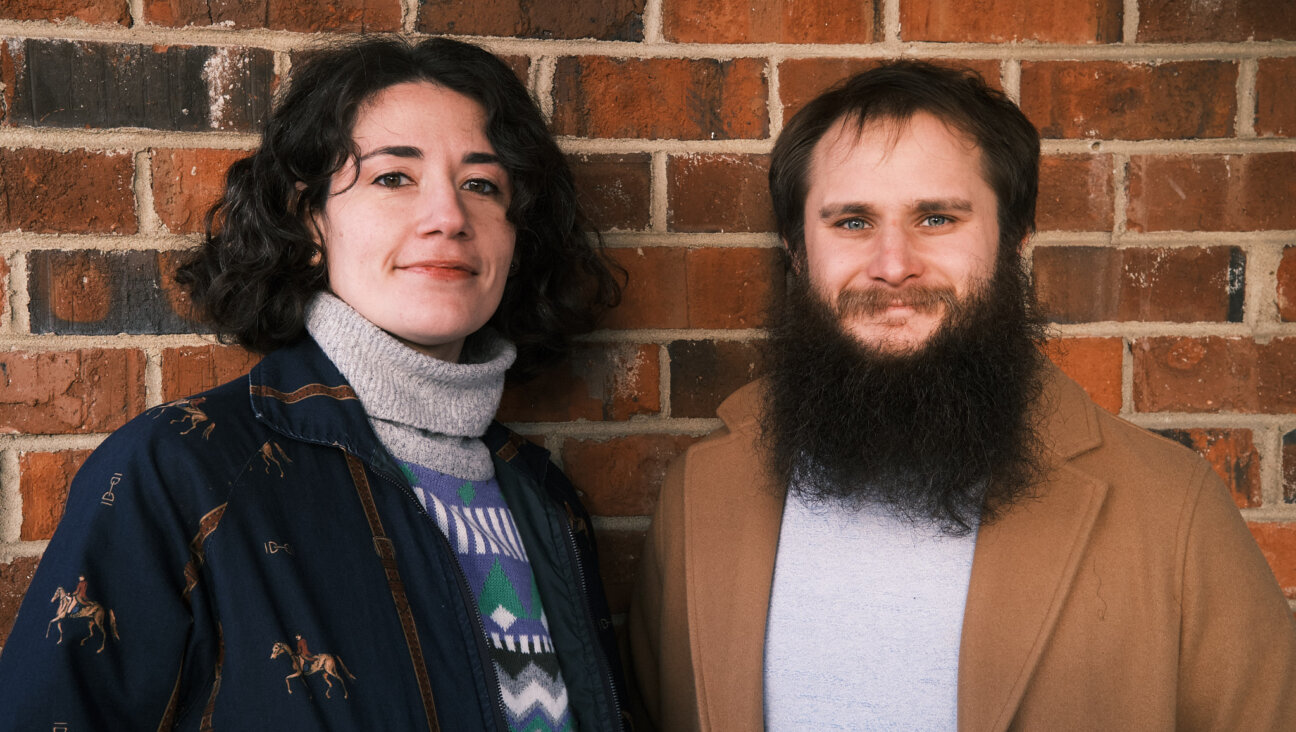Banned from Print Media, Ultra-Orthodox Women Turn to Instagram

Graphic by Angelie Zaslavsky
Orthodox women are disappearing.
Over the years, Orthodox magazines and newspapers have placed a strict ban on any images of women.
And ironically, this erasure has emerged at a time of the community’s increased access to a luxury lifestyle: Orthodox women, decked out in glamorous wigs and haute couture, will ultimately pick up glossy religious magazines in the grocery lines that have zero images that reflect them.
The policy began as a stringency in the Hasidic community, and over the past fifteen years, has become the mainstream in the non-Hasidic Orthodox publishing world as well. Stories related to women feature images of flowers, stainless steel kitchens, wedding canopies, and more flowers. Obituaries of rabbis’ wives and renowned female educators show pictures of the woman’s husband alone. Sometimes, little girls are shown, posing in high-heeled shoes and pearls. According to publishers, the policy is out of sensitivity to modesty, and is mostly due to market forces, to retain its most conservative readership.
Orthodox women have been relatively sanguine about this recent erasure. But a growing number of them have found a way to surreptitiously flout it.
Welcome to the secret social media world of Orthodox Jewish women.
Faced with their own invisibility, many religious women have turned to Instagram: To an alternative media that speaks to them, where a woman can see others who look like her. Open frum Instagram, and you’ll find another subculture, one that’s slowly pushing the boundaries.
For the local version of tabloid gossip — that is, the latest engagements and weddings — follow SimchaSpot (59, 800 followers) and OnlySimchas (58,100 followers). For a more heimishe taste, Yiddishe Simchas (15, 200 followers) will show you mostly Hasidic wedding engagements, young smiling couples from Monsey, Borough Park, Kiryas Joel and New Square standing near ornate flower arrangements or monastic home libraries, flooded with mazel-tov-comments from Mendy’s and Rochel’s.
Kosher food bloggers like Chef Chaya (48,200 followers) and Chanie Apfelbaum (@busyinbrooklyn – 33,500 followers) post recipes and menu ideas. Star cosmetic artist Gitty Berger (21,800 followers), offers tips for the perfect smokey eye, Shimrit Adar (11,900 followers) offers entertainment for bat mitzvahs in her trademark baseball cap and knee-length skirt, while Tanya Rosen (@NutritionbyTanya, 59,000 followers) gives you tips on how to fit into your gown for your sister’s wedding.
Every week, new modest fashionistas appear on the scene and start posting their outfits of the day — following in the footsteps of popular influencers like Adi Heyman (28,600 followers), Abby Klein (@alamodesty – 15,300 followers), Rivkah Levy (@myfashionologygirl – 24,000 followers), and independent fashion designer Tzippy Waltner (@byrd_by_tzippy – 12,400 followers).
Wigs and long skirts, meet Chanel and avocado toast.
And it is among this shameless consumerism, that a strange sort of empowering community has begun to flourish — for housewives and working women alike — no subscriptions needed.
It has become a platform that has emerged as much more powerful, much more potent, than the old-fashioned print publications of the community.
“We have a platform where we do share our faces, and where we can say whatever we want,” said Sarah Lasry, a Lakewood, NJ-based lifestyle blogger with 14,000 followers, in a recent Instagram video.
Those Instagrammers have attained a certain celebrity status in the community, becoming aspirational figures for their followers — which increasingly include Orthodox men, too.
“Lots of young girls and women follow these influencers,” said Elisheva Perlman, founder of The Anelis Group, a boutique marketing company which primarily serves Jewish female business clients.
And it’s empowering, too — something Orthodox women are in need of. It’s a pathway to economic independence, and more, but in a way that doesn’t necessarily challenge community values.
“Through Instagram, we are creating a healthier empowerment for girls, showing them that you can be a business owner or a creative entrepreneur, while balancing it with family life and spirituality,” says Perlman. “We show them that behind the product, there’s a story, and it’s a frum woman who is balancing running a business, placing a grocery order between meetings and turning her phone to silent mode after a full day at a conference to jump into homework mode. She’s wearing a wig, dressed modestly but not compromising her fashion sense, very sharp. She shows her love of Shabbos and yontif, while she focuses on her career. Young girls think, ‘They did it and I can too, and it doesn’t have to be at sacrifice to my family or my growth. I don’t have to sacrifice my principles or religious values to build a career.’”
But those sorts of representations exist only online for religious women.
Everywhere else, female presence seems to be disappearing from the Orthodox public space. More and more magazines, advertisements, and even charity dinner journals will not publish women’s pictures (Hillary Clinton and Angela Merkel famously among them). In most communities, women are not allowed to speak to mixed audiences. And increasingly, mothers’ names are omitted from wedding invitations, lest the mention of a “Rochel” or “Sara” invite male temptation.
And it is on social networks that women congregate, whether on Instagram pages or secret Facebook groups. There, in what they feel is a ‘safe space’, uncensored by any authority, they find reflections of their own faces — women who dress like them, talk like them, face the same concerns and daily frustrations.
These are not the feminists of the Upper West Side; they have likely never read Betty Friedan. They have never raged against the synagogue partition between men and women. They have never raged against not being counted towards a quorum, or not counting as a witness. They have never asked to be called to the Torah, like their husbands and sons are.
These are women who abide by the rules and the uniforms prescribed to them. They go to the right girls’ seminaries and then through the rigors of the matchmaking system. They pursue family-friendly careers. They birth children often in rapid succession, a point of pride for them; they spend years in the blurry mess that is child-rearing. These are women who send their children to ultra-Orthodox schools, despite the educational compromises in secular studies, for the sake of a proper religious upbringing. These are women who invest hours into preparing lavish Shabbat meals, hosting guests, cooking for families with newborns or those sitting shiva.
Yet even here, even among the devout, something seems to be quietly breaking, as women start to speak up.
“We feel stuck, we feel unappreciated, we feel ignored,” wrote one mother, in a private Orthodox women’s group on Facebook. “I am 42 years old. I am raising seven children while working and helping my husband learn [Torah] and pray every day. I need validation and I need it like oxygen. Being pushed around and neglected…is bad for my Yiddishkeit [Judaism]. And I’m brave enough to say so. If that makes me a feminist, then I am proud to be one, and to speak up for my fellow frum women.”
Many are concerned that their daughters have no role models in their own publications, and are subsequently forced to look outside the community. “Girls and women are assailed with [immodest] images from [secular] media, and there is nothing to counteract those images,” said the dean of the Women’s Institute of Torah Seminary/Maalot Baltimore, Dr. Leslie Ginsparg-Klein, in an interview on the popular “Headlines” podcast. “It’s very important for girls to see modest representation, to counteract the other images they see.”
“Pictures have a power that words do not,” wrote Rifka Wein-Harris of Kew Gardens, Queens, a graduate of Bais Yaakov Academy. “It is so crushingly hard already in this generation to be a frum girl. The pressures of perfection and conformity are not healthy ones and they cause grave distortions…Why then are we not giving our girls the benefit of seeing the remarkable diversity of what it is to be a frum woman?”
And the lack of images points to much bigger issues with roles of women in Orthodox society.
“There exists a whole segment of passionate, dedicated, and happy Orthodox women, many of whom are rebbetzins, teachers and [outreach professionals], who feel like second-class citizens when it comes to certain accepted social practices of late in our circles,” wrote Alexandra Fleksher, an Orthodox mother in University Heights, OH, on the popular Orthodox blog site, Cross Currents. “As a vocal Orthodox woman, I feel so misunderstood. You have made women like me to feel we do not belong.”
Recently, Instagram comic personality Adina Miles (known as @FlatbushGirl), took on her local Flatbush Jewish Journal, by placing an ad with a photograph of herself, covering her face with an emoji that is laughing and crying. The newspaper ran the ad, as it was compliant with the newspaper policy to obscure women’s faces. Brooklyn swirled in uproar at the gall of Miles’ mocking community standards.
“My proposition wasn’t even so radical,” she reflected later. “‘You’d think I was talking about abortion rights. I’m living in a twilight zone. This is women’s faces. I can’t even believe I’m talking about this. Our girls are encouraged to going to college and to workforce – yet are left out of their own media outlets. You can’t have it both ways. I get tons of messages from high school girls, and they all say, I open up a newspaper or magazine, and I don’t see role models.”
She said that she is afraid of a society which continues to adopt endless stringencies. “Something like hiding women’s faces has no halachic basis,” she said. “Maybe we should keep Shabbos for two days, pray four times a day? You can’t just add on, it’s just as much a perversion as taking away. They’ve wrapped Jewish law into everything. You can’t even argue anymore.”
After the New York Daily News covered her story, Miles says that she has been harassed by community members for being outspoken. “People tell me I’ve gone about this in the ‘wrong way’, by making a big fuss. Please tell me about how to do this in the right way.” Her voice trembled slightly. “I’ve been part of letter-writing campaigns, quietly, modestly, respectfully, asking for a policy change, tiptoeing behind the scenes – and nothing works.”
She paused.
“Listen, I don’t need the newspapers and magazines,” she said. “I built a platform for myself on Instagram. But I’m fighting for the girls who don’t have that platform.”

















